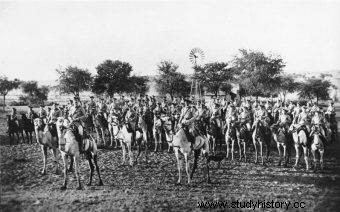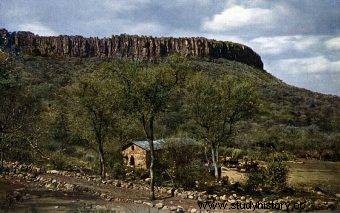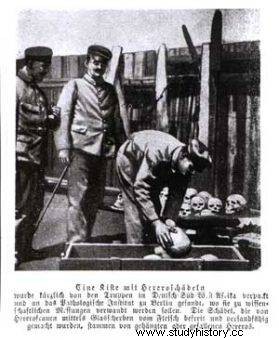They died slowly in the desert, under the scorching sun - of hunger, thirst and exhaustion. The German expeditionary force blocked their access to water. This is how the people of the Herero tribe who dared to rebel against the German colonization of West Africa were "punished". The survivors were forced to backward labor in the first twentieth-century death camps.
The so-called the Herero and Nama uprising broke out in 1904 in present-day Namibia. A dozen or so years earlier - in 1883 - the first German colonists appeared in this part of the Black Continent. The Herero pastoral people had no idea that by agreeing to sell part of the land, they were consenting to expropriation from their homeland . Only a year after the arrival of the pioneers, the German Empire officially announced the founding of colonial German Southwest Africa.
The previous inhabitants of these lands immediately became second-class people. The tension between the natives and the German colonists and the military that arrived in Africa grew rapidly. There were violent incidents. In 1893, a branch of the Schutztruppe (German colonial army) pacified the village of the Nama tribe. Artillery shells flew towards the defenseless people . 80 people died. Some of them were finished with bayonets. Several women were taken from the village as slaves to the German soldiers.
Read also:"If we avoid too drastic descriptions, the genocide organized by the Germans will fade away." Interview with Bartosz T. Wieliński, author of the book "Hitler's Doctors War"
Along with pacifications, the natives also lost the most fertile land. With the help of forgery and deception, they were pushed from water sources to barren areas. In 1903, Germany launched the first reserves for Herero and Nam.
Acts of violence multiplied. The justification for the crime and the taking of land from the natives was the then fashionable Darwinism, expressed in the belief that the stronger, better adapted will survive . Any offenses against whites were punished with great severity. The bodies of those condemned to death hung on the gallows for a long time.
The laws of nature, created by our Lord, are such that only the strong have the right to abide in this world, and the weak and the powerless will be lost to the strong. This phenomenon manifests itself in various ways - for example, after all, the American Indians, because their existence was not conducive to the further development of the world, which strives for the advancement of civilization. In the same way, there will come a time when the Hottentots will be lost [Nama] , no loss to mankind as they are nothing but thieves and bandits, nothing more - this is an example of the opinion of a volunteer who volunteered to fight the Hererami and Nam , Captain Maximilian Bayer.
"We started to hang these black rascals instead of shooting them, and I can assure you that we hang them right" - in turn reported a German correspondent in Namibia with the pseudonym "German Settler".

The Camel Riders Company of the German Schutztruppe during the Herero Uprising, 1904. Bundesarchiv, Bild 183-R24738 / author unknown / CC-BY-SA 3.0
In 1904, local tribes led by the charismatic Samuel Maharero rebelled against German expansion and attacked the colonist forces. In the initial phase of the conflict, it seemed that the natives were able to tip the scales of victory on their side. Soon, however, they were to be met with exceptional ruthlessness and cruelty. The Germans brought General Lothar von Trotha to Namibia, already seasoned in the fighting in the colonies . He described in his diary how he intends to suppress the uprising:
I know enough about the tribes of Africa. They all have the same mentality, and they all count only with strength. It was and is my policy of applying force - absolute terror, even cruelty. I will destroy rebellious tribes by shedding rivers of blood.
Waterberg
On August 11, 1904, the natives gathered about 5,000 warriors on the Waterberg Plateau, above the Kalahari Desert. It was a great feat to deploy such forces. The Namibian tribes were not numerous. The Herers had a total of about 80,000. people. The natives were convinced that the Germans would negotiate.
They did not realize that the first successes of those who were treated as "less valuable" were seen as a slap in the Reich. Emperor William II personally instructed von Trotha to end the war with all his expeditionary forces "by allowed or forbidden methods" .

The Germans brought to Namibia General Lothar Von Trotha, already seasoned in fighting in the colonies. Public Domain
The German corps consisted of 15,000 soldiers. Armed with modern rapid-fire rifles and artillery, the Germans did not intend to negotiate. The clash turned into a massacre - not only of warriors, but also of women and children . The Germans wiped out the tribe's camp and all its belongings - mainly herds of cattle. Soldiers and volunteers killed all living creatures. The natives who overtook the massacre had to flee. Tens of thousands of refugees were moving towards the murderous Kalahari Desert.
Read also:Genocide in Rwanda. Up to a million people were murdered in 100 days in front of the world
Kalahari
After the Herer and the remnants of herds of cattle fled into the desert, von Troth made it clear that it was about extermination. "Any Herero found within Germany, with or without weapons, with or without cattle, will be shot," he told his troops.
The Germans set up patrols on the edge of the desert and guarded the water sources. In August, the Kalahari Desert is dry. It meant a slow but certain death - from thirst, hunger and exhaustion .
Today it is estimated that the leader of the insurgents managed to bring only about 1,000 people to Botswana. The vast majority of them died in agony on the Kalahari. Desperate people dug even several meters long pits in the hope that they would find water. Those who returned to their homes were killed on the spot.

View of Waterberg from the lower station before 1910
When in Berlin it was decided that the natives had already been punished enough, the order to kill on the spot was lifted. However, it was not the end, but only the beginning of the wave of crimes.
Read also:Forgotten camps. German crime scenes in Poland that are far too rarely mentioned
Death Camps - prologue
The remnants of the natives of the Namibian tribes began to be sent to Shark Island - to the first 20th-century death camp. The location itself was extremely unfriendly. A bitter, gusting wind was blowing here. The area was surrounded by barbed wire. A brick watchtower was built. The German camp guards lived in tin barracks. African natives - in huts made of branches and rags. They slept on the bare ground .
The Germans established six such camps throughout Namibia. Tribal groups that did not take part in the uprising were also herded there. About 40 percent of people died during the first two months of their stay.
They were placed behind double barbed wire (...), in pathetic constructions made of boards and rags, in such a way that one of them had to fit 30-50 people , no division by gender or age. They have to work from early morning until late at night, including weekends, Sundays and public holidays, bending under the blows of the clubs of brutal overseers until they fall. There is very little food. Rice without any additives is not enough for their bodies (...) to withstand the cold and exhausting effort in prison conditions (...). Hundreds of them are led to their death like cattle and hide them like cattle - write David Olusoga, Casper W. Erichsen in the book "Zbrodnia Kajzera".

Herero prisoners. Bundesarchiv, Bild 146-2003-0005 / author unknown / CC-BY-SA 3.0
It was then that the idea of a "final solution" to the problems was born with those he stripped of his humanity he treats as things.
Prisoners were marked with a number tattooed on their forearms, starved and forced into slave labor. All of them locked up in camps, fenced off from the world with barbed wire […]. The Germans had a problem with the Nama people. They were less durable than Herer, they were not fit for hard, physical work. Those locked up in concentration camps did not bring any prospective benefits to the colonial authorities, and the disastrous reputation they had among the German colonists pushed the Germans to implement a policy of extermination of indigenous peoples on a scale so far unprecedented. (…) - writes Wojciech Rogala, author of the report "Welcome to White Africa".
Prisoners were beaten to death, shot and starved. Women were raped, serving as slaves . Today it is frightening how many of the later crimes of World War II in terms of modus operandi had its prototype for this German genocide in Africa. An example would be scientific experiments carried out to investigate "inferior" racially.
Read also:The human zoo, or peeping "wild"
(...) conducted medical experiments on prisoners. Eugen Fischer studied the differences of races in terms of physical and mental characteristics. He was especially interested in mixed breeds. (...) Bofinger's role was to select. He looked at the prisoners and chose those who were characterized by anthropological features interesting in his opinion. Such people were killed, their heads were cut off and preserved in formalin, then sent to Berlin as research exhibits . Both doctors sent about 780 Negro heads. Each of them was carefully measured, described and cataloged. (…) - writes Rogala.
Unsettled crime
The Whitaker Report from the 1950s calls the German crimes in Namibia the first genocide of the 20th century. Today it is estimated that of the 80,000 members of the Herero people only 15,000 survived, and they lost all rights and all property. They were under police surveillance and worked on white farms.

Such persons were killed, their heads were cut off and preserved in formalin, and then sent to Berlin as research exhibits. Public domain.
It was only in 2004 that the Germans officially admitted to these crimes and apologized for them . However, the issue of compensation for the committed genocide remains unsettled. Germany has pledged payments of € 1.1 billion over 30 years. Recently, however, representatives of the Namibian Herer have rejected this proposal, considering it offensive. Their demands include 8 trillion Namibian dollars, or as much as 445 billion euros .
The Namibian genocide was a grim prediction of what would happen during World War II. Unfortunately, no one could read this prophecy at the time.
The African crime proves that the later dictator of the Third Reich, responsible for hell on earth, was not only a "specific" individual who, thanks to his personal characteristics, managed to take control of the crowd, deceive it and implement his possessed ideology. The ideas he had creatively developed, a definite picture of the world and consent to what was happening both in Namibia and beyond, existed in German society long before Adolf Hitler took power.
Bibliography:
- Paweł Brudek, German colonial troops in East Africa 1886-1918 , Oświęcim 2016.
- John Iliffe, Africans. The History of the Continent , Krakow 2011.
- David Olusoga, Casper W. Erichsen, The Kajzer Crime , Warsaw 2012.
- Wojciech Rogala, Welcome to White Africa , Warsaw 2017.
